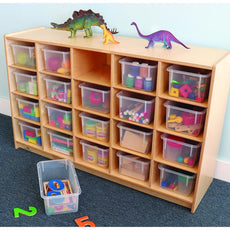
Preschool Cubby Buying Guide
Discover the perfect preschool cubbies to keep your early learning classroom organized and clutter-free. This guide will help you choose a suitable option based on your sizing, storage needs, and safety features.
School Outlet’s Tips
-

Assess the Size and Space
Measure your classroom to find cubbies that fit without overcrowding. Consider students' storage needs and other furniture. Determine the right size and number of cubby openings.
-

Look for Child-Friendly Design
Choose cubbies with rounded corners to prevent injuries. Ensure they are height-appropriate for kids to access independently. Features like easy-to-grasp handles promote self-help skills.
-

Consider Material and Durability
Opt for durable materials like laminated wood, plywood, or sturdy plastic that are easy to clean. Look for UV finishes to protect against stains and sun exposure. Eco-friendly certifications like GREENGUARD ensure low chemical emissions.
-

Evaluate Storage Needs
Choose cubbies based on the size and quantity of items to be stored. Larger openings with hooks are good for coats and bags, while smaller cubbies with bins organize smaller items.
-

Check for Flexibility and Modularity
Units with casters allow for easy mobility. Stackable or interlocking components let you adjust the setup based on class size and storage needs.
-

Prioritize Safety
Select cubbies with safety certifications like CPSIA and GREENGUARD. Look for rounded edges, non-toxic finishes, and secure wall-mounting options to prevent accidents.
Preschool Cubby Styles
-
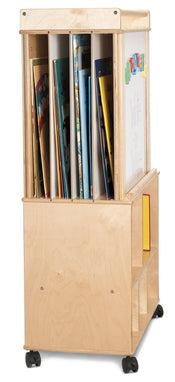
Jonti-Craft Classroom Lockers & Storageategory
Jonti-Craft's classroom lockers and storage units offer various options to suit multiple needs. From traditional lockers with doors and hooks to open cubbies with tubs, these durable and attractive units are designed to keep your classroom organized and clutter-free. They are constructed from high-quality materials like birch plywood or laminate.
-
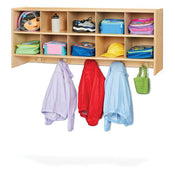
Young Time Wall Locker Units
The Young Time Wall Locker Units are space-saving solutions that mount securely to the wall. They free up valuable floor space in your classroom. These units have multiple compartments and hooks and store backpacks, jackets, and other personal belongings. The compact design maximizes vertical space while maintaining an open, uncluttered feel.
-
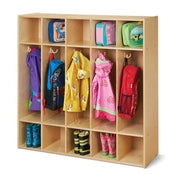
Young Time Lockers & Coat Racks
The sturdy Young Time Lockers and Coat Racks feature multiple compartments, hooks, and shelves to keep your classroom tidy. They are crafted from durable materials like wood or laminate to withstand the rigors of daily use. The laminated corners and thermo-fused edgebanding make the unit safe for your classroom. They come with a lifetime guarantee for your peace of mind.
-
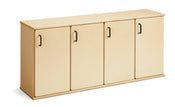
Young Time Stackable Lockers
The Young Time Stackable Lockers can be stacked up to three units high. You can create customized storage solutions that grow with your classroom. The included brackets allow you to mount these units to the wall. The adhesive is formaldehyde-free, and the corners are rounded to create a safe learning environment.
Frequently Asked Questions
-
You can ensure it by selecting cubbies with safety certifications like CPSIA and GREENGUARD. These certifications guarantee the cubbies have been rigorously tested for harmful substances and meet stringent safety standards. Units with rounded corners prevent injuries from sharp edges, and tip-resistant designs or secure wall-mounting options prioritize student safety. Stable, anchored cubbies allow little ones to access their belongings without the risk of the unit toppling over.
-
You can clean and maintain it by wiping the surface with disinfectant solutions or mild soap and water. Wooden cubbies require more delicate cleaning methods to prevent scratches, so always follow the manufacturer's instructions. Check for loose joints and mounts and maintain them to avoid the cubbies from coming apart.
-
Encourage independence and organization by selecting cubbies with clear labels or color-coding systems that help children identify their designated storage space. Units with age-appropriate heights and openings sized for little hands help your ones access their belongings easily without assistance. Include bins or tubs for further compartmentalization so students can sort and store their items neatly.
-
You can secure freestanding cubbies to the wall using appropriate hardware and following manufacturer instructions. Install proper anchors or mounting brackets to keep the unit firmly in place. The cubbies have built-in stabilizing features like weighted bases or low centers of gravity that prevent tipping. Avoid placing them in high-traffic areas where they could be inadvertently knocked over.













